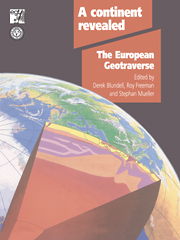4 - EUROPE'S LITHOSPHERE – PHYSICAL PROPERTIES
Published online by Cambridge University Press: 05 November 2009
Summary
PHYSICAL PROPERTIES OF THE LITHOSPHERE
There are two ways of discovering the nature of the rocks in the Earth that are too deep to be directly accessible by drilling. The first is by means of geophysical observations made at the Earth's surface to determine in situ the physical properties in its interior. In the last Chapter we reviewed the evidence that can be obtained from measuring the passage of seismic waves through the ground. In this chapter we consider other geophysical methods. First, we use measurements of the outward flow of heat from the Earth's interior to try to find out the temperatures of rocks at depth. We then make use of observations of gravity mapped over the Earth's surface and corrected for the effects of elevation and latitude on the gravity field. The residual, Bouguer gravity anomalies are indicative of localised mass deficiencies or excesses within the Earth which can be interpreted in terms of density contrasts between various units. Because there is no unambiguous interpretation of gravity data, models are usually presented that are constrained by other evidence, such as the seismic structure cross sections shown in Chapter 3, and by reasonable values of density for rocks likely to be present. Variations in the Earth's magnetic field mapped over its surface and suitably corrected for global effects, also record regions where rocks are magnetised sufficiently to create local perturbations of the main geomagnetic field. Magnetic anomaly maps can, like gravity, be interpreted in terms of the spatial distribution of magnetic rocks.
- Type
- Chapter
- Information
- A Continent RevealedThe European Geotraverse, Structure and Dynamic Evolution, pp. 71 - 110Publisher: Cambridge University PressPrint publication year: 1992
- 10
- Cited by



